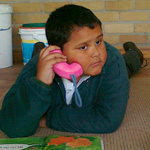Learners bring their Sebezaphones with them when called to sit ‘on the mat’ with the teacher. Change “Choral Responses” to Sebezaphone responses where every child is responsible for responding for him/herself. For example, when the teacher asks all learners to respond in Chorus, such as reading words or sentences from the Big Book, have all …
Category Archive: How to use the Sebezaphone to enhance reading instruction
Shared and Guided Writing Periods
After doing a Shared Writing Activity, have all learners re-read into their Sebezaphone the piece they have just written with the teacher. Invite them to consider different ways they could improve and/or edit the writing. When learners have completed doing a writing assignment, have them read it aloud into their Sebezaphone to listen to how …
Making meaning from text: the direct teaching of metacognition
Introduce learners to the concept of metacognition by asking them to think about how they go about making meaning from what they read. Lead them to discover that good readers are good thinkers, and that while they read they need to be aware of how ‘the voice inside their heads’ needs to dialogue with the …
Word and Sentence Level Work
Systematic, direct instruction to enable learners to better differentiate the phonetic sounds and letter patterns for decoding and encoding words. The Sebezaphone is an effective tool in establishing the essential link between sound and print because it helps the learner focus on the ‘sound’ of the print/letter patterns. Phonemic Awareness: The Sebezaphone is a fantastic …
Free Reading Period: “DEAR” = “Drop Everything and Read” Independent Reading
Learners can use the Sebezaphone anytime they practice reading independent. Daily reading is critical to building reading skills. Reading into the phone focuses learners more closely on exactly what they are reading. Provide learners with level appropriate reading material and remind them that they need only whisper into the mouthpiece of their phones, and they …





